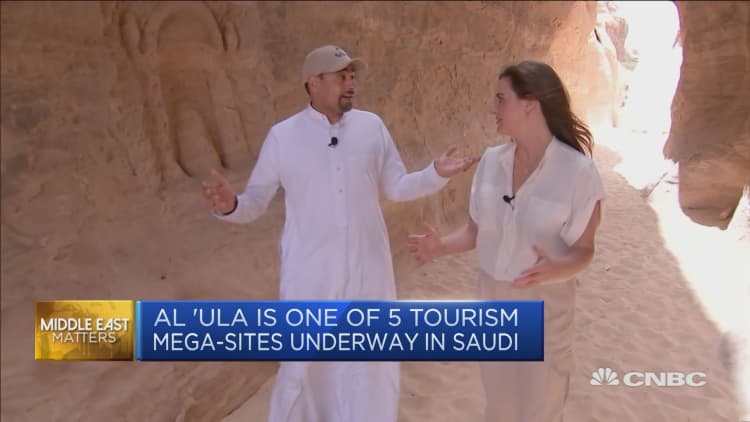
RIYADH, Saudi Arabia — Crown Prince Mohammad bin Salman hopes to see tourism contribute 10% of Saudi Arabia's gross domestic product by 2030 — and the country plans to tap everything from a 2,000-year-old UNESCO heritage site to the "the longest, tallest and fastest roller coaster in the world" to make it happen.
Next month, Saudi Arabia will introduce a new tourism visa that it hopes will attract foreign visitors. Currently, the Kingdom's visa process requires a letter from the government.
Six Flags is the first major international theme park operator to sign up for Saudi Arabia's Qiddiya project, an "entertainment super-city" under construction 40 kilometers (25 miles) outside Riyadh.
"At Six Flags Qiddiya, we're going to be debuting 28 rides, of which 12 of those will be world record-breakers," Six Flags President of International Park Operations David McKillips told CNBC on Sunday.
Many of the country's goals — it says it wants to become one of the world's top five destinations for tourists — are ambitious. Qiddiya is one of several mega-projects under development inside Saudi Arabia that it's hoped will contribute to a total of a million new jobs. Qiddiya, its backers say, will chip in 17,000 off the bat.
"It's kind of a two-sided coin," Qiddiya Investment Company CEO Michael Reininger told CNBC. "On the one hand, we're opening up these opportunities that create lifestyle experiences and quality of life experiences through entertainment, sports and the arts, but in order to do that, we also create economic opportunities in the form of jobs, spending and all of the economic power that comes out of that sort of thing."
The murder of journalist Jamal Khashoggi last October strained Riyadh's ties with the West, but the Kingdom wants to repair its image among the international community and investors.
McKillips of Six Flags said he's not worried about any fallout from the killing.
"We take a look at the investment opportunity, and we're very proud of where (Bin Salman's) Vision 2030 is going, and to be on the forefront," he said. "I've already been working here for the last year and a half, and I've seen a tremendous advancement in the society and the culture and we're very, very proud to be a part of that advancement."
It's not just theme parks and roller coasters. Eco-tourism is a big focus for Amr AlMadani, the CEO for the Royal Commission for Al-Ula, a UNESCO site.
"Trends show that people travel now for intimate interaction with nature, low-key and low-density," he said.
Keeping Saudi money at home
Saudis today spend as much as $26 billion outside the Kingdom each year on everything from luxury products and leisure to entertainment, and that's money the Crown Prince is hoping to lure back to the country.
Last year, Saudis spent $10 billion outside of the Kingdom on the kinds of goods and services that Qiddiya is offering —entertainment, sports and the arts.
Two thirds of the Saudi population is under 35, a project like Qiddiya provides huge economic opportunity, Reininger said.
"What we're talking about is building a product base that is accessible to a huge marketplace — about 8 million people right on the doorstep here in Riyadh alone, said Reininger, who estimates there's a total market of 20 million Saudis who "today don't have the opportunity to get what they are looking for, but for leaving the country. So we make it as good as they can get anywhere else" and now, Reininger said, that entertainment is right on their doorstep."
Total tourism revenue today accounts for around 2% of Saudi Arabia's GDP, but with three tourism mega-projects under development, the country's sovereign wealth fund is hoping to boost that revenue with a major injection of cash. Qiddiya, the $500 billion NEOM, and the Red Sea Project all operate with support from Saudi Arabia's Public Investment Fund.
Saudi Arabia's foreign tourism market has depended almost exclusively on the millions of pilgrims who enter the Kingdom each year to perform Hajj. While that number looks set to increase by as much as 30 million pilgrims by 2030, the government hopes that the launch of visas for foreigners will open up the largely closed country to a whole new market.



